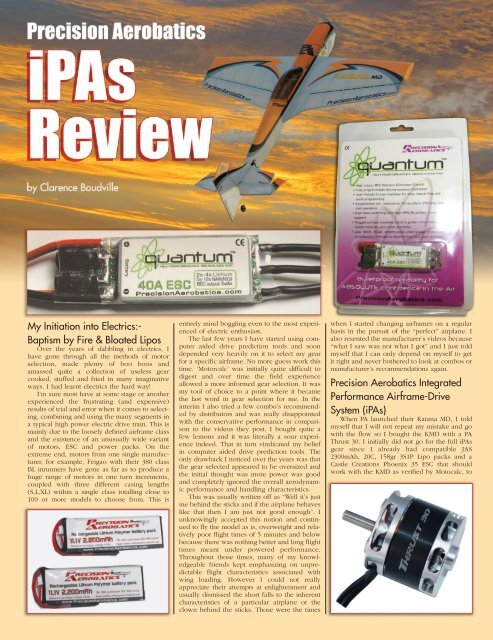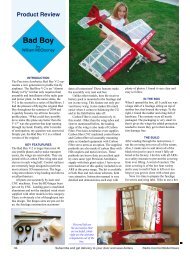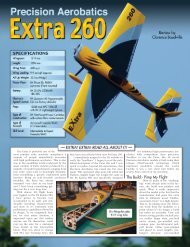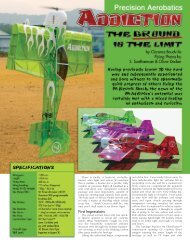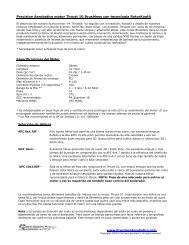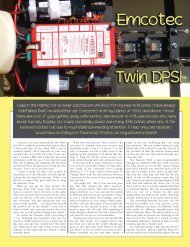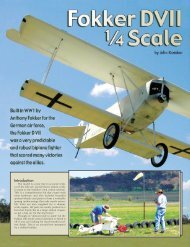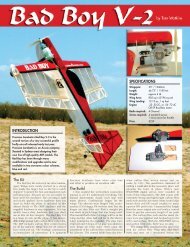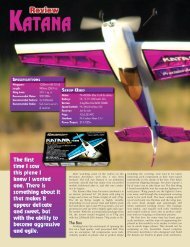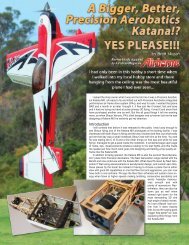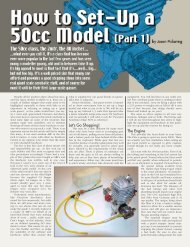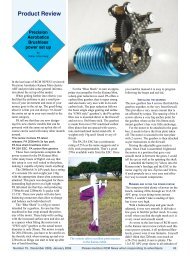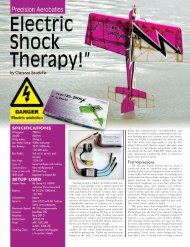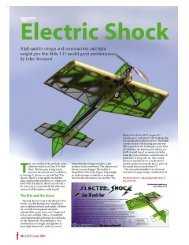IPAs review Airborne magazine.pdf - Precision Aerobatics
IPAs review Airborne magazine.pdf - Precision Aerobatics
IPAs review Airborne magazine.pdf - Precision Aerobatics
Create successful ePaper yourself
Turn your PDF publications into a flip-book with our unique Google optimized e-Paper software.
My Initiation into Electrics:-<br />
Baptism by Fire & Bloated Lipos<br />
Over the years of dabbling in electrics, I<br />
have gone through all the methods of motor<br />
selection, made plenty of boo boos and<br />
amassed quite a collection of useless gear<br />
cooked, stuffed and fried in many imaginative<br />
ways. I had learnt electrics the hard way!<br />
I’m sure most have at some stage or another<br />
experienced the frustrating (and expensive)<br />
results of trial and error when it comes to selecting,<br />
combining and using the many segments in<br />
a typical high power electric drive train. This is<br />
mainly due to the loosely defined airframe class<br />
and the existence of an unusually wide variant<br />
of motors, ESC and power packs. On the<br />
extreme end, motors from one single manufacturer,<br />
for example, Feigao with their 380 class<br />
BL inrunners have gone as far as to produce a<br />
huge range of motors in one turn increments,<br />
coupled with three different casing lengths<br />
(S,L,XL) within a single class totalling close to<br />
100 or more models to choose from. This is<br />
entirely mind boggling even to the most experienced<br />
of electric enthusiast.<br />
The last few years I have started using computer<br />
aided drive prediction tools and soon<br />
depended very heavily on it to select my gear<br />
for a specific airframe. No more guess work this<br />
time. ‘Motorcalc’ was initially quite difficult to<br />
digest and over time the field experience<br />
allowed a more informed gear selection. It was<br />
my tool of choice to a point where it became<br />
the last word in gear selection for me. In the<br />
interim I also tried a few combo’s recommended<br />
by distributors and was really disappointed<br />
with the conservative performance in comparison<br />
to the videos they post. I bought quite a<br />
few lemons and it was literally a sour experience<br />
indeed. That in turn vindicated my belief<br />
in computer aided drive prediction tools. The<br />
only drawback I noticed over the years was that<br />
the gear selected appeared to be oversized and<br />
the initial thought was more power was good<br />
and completely ignored the overall aerodynamic<br />
performance and handling characteristics.<br />
This was usually written off as “Well it’s just<br />
me behind the sticks and if the airplane behaves<br />
like that then I am just not good enough”. I<br />
unknowingly accepted this notion and continued<br />
to fly the model as is, overweight and relatively<br />
poor flight times of 5 minutes and below<br />
because there was nothing better and long flight<br />
times meant under powered performance.<br />
Throughout those times, many of my knowledgeable<br />
friends kept emphasizing on unpredictable<br />
flight characteristics associated with<br />
wing loading. However I could not really<br />
appreciate their attempts at enlightenment and<br />
usually dismissed the short falls to the inherent<br />
characteristics of a particular airplane or the<br />
clown behind the sticks. Those were the times<br />
when I started changing airframes on a regular<br />
basis in the pursuit of the “perfect” airplane. I<br />
also resented the manufacturer’s videos because<br />
“what I saw was not what I got” and I just told<br />
myself that I can only depend on myself to get<br />
it right and never bothered to look at combos or<br />
manufacturer’s recommendations again.<br />
<strong>Precision</strong> <strong>Aerobatics</strong> Integrated<br />
Performance Airframe-Drive<br />
System (iPAs)<br />
When PA launched their Katana MD, I told<br />
myself that I will not repeat my mistake and go<br />
with the flow so I bought the KMD with a PA<br />
Thrust 30. I initially did not go for the full iPAs<br />
gear since I already had compatible JAS<br />
2300mAh, 20C, 158gr 3S1P Lipo packs and a<br />
Castle Creations Phoenix 35 ESC that should<br />
work with the KMD as verified by Motocalc, to
e a very good setup. The AWT came out close to spec and the KMD flew<br />
like “as seen on TV” and I was delighted at the outcome but was still very<br />
curious about their iPAs stating that the gear was exhaustively tested on<br />
the specific airframe to attain an optimum combination. I was quite curious<br />
to know as to how far off be my setup in relation to the optimum<br />
specified by PA. When PA recently launched their combo deal plus free<br />
global shipping, it was very hard to resist and I got one along with the<br />
PA2200mAh, 18-30C Lipo pack to test things out, just to find out if there<br />
are any significant difference in performance with the ancillary drive gear<br />
beyond the motor.<br />
Prior to receiving my new PA gear, I used EagleTree Micro E-logger to<br />
take flight data logs of my previous setup to establish a baseline of my<br />
current performance. Motor Temperature, RPM, Current, Pack Voltage and<br />
cumulative milli-Amps were logged for each flight with a flight time set<br />
for 8 minutes. The same would be done for the new gear from PA as I<br />
plan to push both gears really hard without the risking unwanted LVC.<br />
The KMD is also flown with the average 3D/Freestyle manoeuvres<br />
consisting of harrier rolls, hovers, torque rolls, knife edge, snaps, water<br />
falls, inverted harriers, up-right harriers, inverted and upright spins and<br />
walls since this was the intended flight performance of the KMD and how<br />
it should be flown.
It is very interesting to note that although the static bench test results<br />
appears to be relatively close, the dynamic test results shown on the<br />
graphs clearly indicates the difference in actual flight. This indicates that<br />
the traditional method of using static bench test results alone is not necessarily<br />
a definitive indication of the drive’s performance because evidence<br />
shows that it does not reflect what is actually happening in flight,<br />
and what actually happens in flight matters the most and therefore can<br />
not be accurately simulated on a bench. As such static bench test either<br />
conducted on the bench or derived from computer aided applications<br />
appears to have some limitations.
This also helps answers as to why there<br />
was a performance difference noted between<br />
my “should work” set up versus the optimum<br />
recommended by PA and finally tells me how<br />
far I can only go with computer aided drive<br />
prediction applications.<br />
Testing the Effectiveness of<br />
RotorKool:-<br />
How cool is cool?<br />
In order to find out the effectiveness of the PA<br />
Thrust 30,s RotorKool features, I used an equivalent<br />
100gr class Hacker A30-16M on its max<br />
prop of 12X6E with the same ESC and motor used<br />
in Graph 1, (i.e. Castle Creations Phoenix 35A<br />
and JAS 3S1P 2300mAh, 20C pack) in order to<br />
keep the playing field level as best I can. This<br />
was flown on a smaller and lighter Katana Mini to<br />
balance out the prop size limitations imposed by<br />
the motor. Please refer to the graph for the temperature<br />
trace and compare to the table using the<br />
same controller and Lipo packs. No changes were<br />
made to the ESC programming.<br />
As observed from the temperature trace, the<br />
non-RotorKool equipped Hacker A30-16M<br />
operates at a much higher temperature while the<br />
range within the temperature oscillation are also<br />
much higher. The motor also appears to become<br />
progressively hotter. When compared to Graphs<br />
1 & 2 the RotorKool equipped Thrust 30’s temperature<br />
measurements appears to be relatively<br />
flatter with smaller oscillations and does not<br />
appear to be getting progressively hotter. This<br />
indicates that motor temperature is being controlled<br />
by the innovative High Velocity Force<br />
Cool Ventilation (HFCV) feature and kept within<br />
a small & stable temperature range. RotorKool<br />
also appears to help the motor operate at a much<br />
lower temperature which indirectly implies that<br />
the health of the neodymium magnets will be<br />
much better. Therefore, I would believe that the<br />
cooler running Thrust 30 could possibly provide<br />
a much longer and consistent service life in relation<br />
to a much hotter running motor.<br />
Conclusion<br />
From the graphs, it becomes obvious that the<br />
performance offered by the iPAs setup is superior<br />
to the “should work” mix and match setup as well<br />
as the importance of dynamic flight testing. The<br />
iPAs gear certainly appears to be optimally selected<br />
and provides the best performance as advertised.<br />
This also shows what could be achieved out<br />
of a non-iPAs, semi-iPAS and full iPAS setup.<br />
I am convinced that the iPAs setup provides<br />
the best option for any modeller to attain optimum<br />
performance. The plus side with the iPAs<br />
option is that it allows any modeller to attain<br />
the best performance without the need to<br />
undertake an extensive and complicated drive<br />
selection process. This appears to be truly performance<br />
out of the box and I would highly recommend<br />
the iPAs option.<br />
The iPAs components are available directly<br />
from <strong>Precision</strong> <strong>Aerobatics</strong> and from good<br />
hobby shops around Australia. For more<br />
details visit <strong>Precision</strong><strong>Aerobatics</strong>.com<br />
or call 02-9558 0443.


